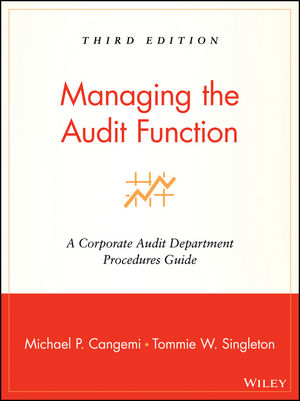Managing the Audit Function: A Corporate Audit Department Procedures Guide, 3rd EditionISBN: 978-0-471-28119-1
Paperback
384 pages
April 2003
 This is a Print-on-Demand title. It will be printed specifically to fill your order. Please allow an additional 10-15 days delivery time. The book is not returnable.
|
||||||
Praise for Managing the Audit Function
"The corporate governance issues, accounting irregularities, and legislative actions that have taken place over the past two years have elevated the role and importance of the internal audit function. Managing the Audit Function provides a valuable guide and reference tool for those charged with either executing or overseeing this function."
-- Daniel S. Kaplan, Business Risk Services Partner
Ernst & Young LLP
"It was refreshing to read Internal Audit literature with the appropriate focus on information systems and information systems auditing, since computer systems play such a key role in the processing of accounting transactions and the performance of business operations in today's business environment."
-- William J. Powers, Partner, National Director
Information Systems Assurance Services
BDO Seidman, LLP
"Cangemi and Singleton have created a knowledge management tool for the creation of quality audit manuals and functions. Managing the Audit Function is an important book for all audit managers, and with the addition of new and updated material, including information on the implications and requirements of the Sarbanes-Oxley Act, it provides the information to keep pace with changing conditions affecting the audit function."
-- Robert S. Roussey, Professor of Accounting
Leventhal School of Accounting, University of Southern California
International President, Information Systems Audit and Control Association
" This is basically a procedures manual for an internal auditing department that has been prepared by two of the world's most knowledgeable IT auditors. The book is a handy tool because examples are given throughout of relevant audit documents, such as audit reports, responses to reports, responses to delinquent responses, matrices, checklists, and flowcharts. Every audit department should have this book as a reference manual."
-- Dale L. Flesher, PhD, CPA, CMA, CIA, CFE, CGFM
Professor of Accountancy and Associate Dean
University of Mississippi
"The corporate governance issues, accounting irregularities, and legislative actions that have taken place over the past two years have elevated the role and importance of the internal audit function. Managing the Audit Function provides a valuable guide and reference tool for those charged with either executing or overseeing this function."
-- Daniel S. Kaplan, Business Risk Services Partner
Ernst & Young LLP
"It was refreshing to read Internal Audit literature with the appropriate focus on information systems and information systems auditing, since computer systems play such a key role in the processing of accounting transactions and the performance of business operations in today's business environment."
-- William J. Powers, Partner, National Director
Information Systems Assurance Services
BDO Seidman, LLP
"Cangemi and Singleton have created a knowledge management tool for the creation of quality audit manuals and functions. Managing the Audit Function is an important book for all audit managers, and with the addition of new and updated material, including information on the implications and requirements of the Sarbanes-Oxley Act, it provides the information to keep pace with changing conditions affecting the audit function."
-- Robert S. Roussey, Professor of Accounting
Leventhal School of Accounting, University of Southern California
International President, Information Systems Audit and Control Association
" This is basically a procedures manual for an internal auditing department that has been prepared by two of the world's most knowledgeable IT auditors. The book is a handy tool because examples are given throughout of relevant audit documents, such as audit reports, responses to reports, responses to delinquent responses, matrices, checklists, and flowcharts. Every audit department should have this book as a reference manual."
-- Dale L. Flesher, PhD, CPA, CMA, CIA, CFE, CGFM
Professor of Accountancy and Associate Dean
University of Mississippi



